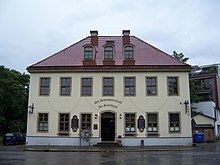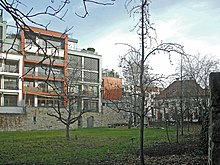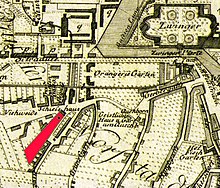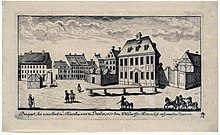Shooting house (Dresden)
The shooting house on the cattle pasture in front of the Wilsdruffer Tor was a shooting range for rifle shooters from 1554 to 1873 under the authority of the Dresden City Council . At the same time, the electoral court maintained a shooting house built by Johann Georg Starcke between the residential palace and the Zwingerwall to the west .
history
Emergence
The Dresden archery probably began long before it was first mentioned in 1446, when Elector Friedrich II privileged crossbowmen and placed them on an equal footing with the guilds . On the basis of a medieval defense constitution, the city council was responsible for internal and external security. For this purpose, citizens capable of military service were made familiar with the weapons trade and used for guard and defense tasks. For regular practice shooting with the crossbow , the council maintained a council shooting range on the northeastern city wall. With the introduction of new defense technology, parts of the crossbowmen changed their armament and became rifle shooters. Initially, heavy, unwieldy hook boxes , which were replaced at the beginning of the 16th century by the much more manageable arquebuses , found their way into the city's defense system. For the council, the damage in the council's shooting range, which was affected by the inaccuracy and greater penetration of the rifle bullets, became a problem. Added to this were the worsening discrepancies in the interpretation of the shooting regulations during joint practice shooting between the archers and rifle shooters. As a result, the council ordered the rifle shooters to set up their own practice area on the cattle pasture in front of the Wilsdruffer Tor by setting up temporary shooting walls and later to build a shooting house there. This was accompanied by the official separation of the rifle shooters from the archery society in 1549 .
First council shooting house
On the occasion of the opening and completion of the first council shooting house on October 9, 1554, Elector August had a shooting carried out and a cliff made of silver was struck by the city mint master Leupold Holzschucher . Today it is one of the oldest numismatic exhibits in the city and is on display in the Münzkabinett of the Staatliche Kunstsammlungen Dresden .
During the Thirty Years War the building served as a hospital and was badly damaged by destruction and looting. It was located at today's eastern end of Grüner Strasse, immediately behind the Duchess Garden .
Second council shooting house
In 1656 the city council received the instruction from Elector Johann Georg II to rebuild the destroyed first shooting house. In the past forty years since the beginning of the Thirty Years' War, illegal residential buildings have been built in the immediate vicinity of the council shooting range. Contrary to a council resolution to demolish the houses, the new building site was moved to the north-west at the request of the owners. After a year of construction, the shooting house was put into operation on April 25, 1658. Like the previous one, it was made of wood . The four firing ranges had a length of 163.68 meters and were enclosed by a wall to the threat to the neighborhood by ricochet excluded. Despite all the safety measures, the number of complaints increased because of the alleged danger to life from the shooting range. The council then increased the shooting walls and had protective screens built in from thick wood. Nevertheless, the dispute continued to come to a head. In 1726 the electoral justice department asked the Dresden City Council for the first time to move the shooting range.
The council then looked for suitable alternative locations for a new council shooting range together with the electoral building authority. After a detailed examination of all possible locations, the council favored the safety-related expansion of the existing system. In 1763 it was found that the shooting house was in a state of disrepair, favored by worm and mold infestations. The association of rifle shooters, now organized as a target shooting company , applied to the regent of the electorate , Prince Xaver of Saxony, for the necessary renovation of the house.
Third council shooting house
This application was granted and in 1766 the construction of a stone building now started on today's corner where “Schützengasse” and the street “Am Schießhaus” meet. The alignment was based on the existing building fabric, with the new shooting house now being placed opposite the old one. The construction costs amounted to a good 1,500 thalers and were borne entirely by the city treasury. On October 31, 1768, the council shooting range, built according to the latest safety regulations, went into operation.
After a long period of rest, the residents tried again in 1825 to stop the shooting. The state government repeatedly advised the council to move the shooting house to another location. All efforts to meet this requirement were in vain and mostly failed due to the resistance of the property owners or the negative decisions of the responsible approval authorities.
This procedure has been repeated more than seventeen times to date. In 1840 the Schützengesellschaft expressed that it would no longer take part in the search for new locations due to the lack of cooperation on the part of the authorities. She questioned the threats presented by the complainants and referred to grandfathering. In the end, the shooting house stood first and only later was it illegal to settle there. After the royal artillery commission had checked the safety precautions again, in 1842 permission was issued to continue operating the facility for the time being.
In 1869 the Dresden riflemen got into trouble again. In the city council, the homeowners' interest groups made the front and demanded that the special position of the entire Dresden shooting industry, which had existed for 423 years, be put to the test. Some MPs took the view that subsidies based on old privileges were no longer appropriate and called for their abolition. Others forced the suspension of target practice on the Rats shooting range until legal certainty was established. In addition, pressure was built up on the part of the royal district administration in the matter of the requested relocation. So it happened that on January 7, 1870, the city council released itself from any responsibility towards the shooting scene and entrusted the target shooting company with the procurement and relocation of the shooting range.
closure
In a council resolution in 1873 the immediate closure of the council shooting house and its shooting ranges was ordered. This ended the centuries-old relationship between the city and its rifle shooters. In exchange, they received 20,000 thalers and in 1874 they acquired a piece of land in the Trachau district of Dresden on which they built their own shooting range.
Conversion
After the Scheibenschützengesellschaft left, the building of the former Ratsschießhaus was briefly used as a residential building and, from 1896, was used by the “Chemical Investigation Office of the City of Dresden”. During the bombing raids in 1945, the house was the only building in the area that was spared from destruction. After 1945 parts of the administration of the Robotron combine rented space , then the FDJ district management Dresden-Mitte, the office for medical statistics and the energy and environment department of the city council. From 1989 onwards there was vacancy and decay due to vandalism and erosion. In 1994 the Dresden District Craftsmen's Association was awarded the contract with its proposed usage concept - a meeting place for the crafts including catering. She invested around 3.5 million German marks to hand over the building to its new purpose in December 1996. The former shooting range in the rear part of the property remained as an inner-city green area. The privately run restaurant "Zum Schießhaus" is located in the former Rats-Schießhaus.
literature
- Katrin Reeckmann: The beginnings of baroque architecture in Saxony, Johann Georg Starcke and his time . Böhlau, Cologne 2000, ISBN 3-412-03200-X
- G. Adolph Schulze: History of the privileged archery society in Dresden . Self-published, Dresden 1913.
- Heidrun Wozel: The Dresden bird meadow . Verlag der Kunst, Dresden, 1993, ISBN 3-364-00284-3
- Heinrich Moritz Neubert : The rifle clubs in Dresden in their legal relationships with the community . Dresden 1872
- Fritz Löffler : The old Dresden, history of its buildings . EA Seemann, Leipzig 1989, ISBN 3-363-00007-3
- Uwe Steffen: The old council shooting house and its changing locations from the 15th to the 20th century . In: Dresden History Book Vol. 15 . Edited by the Dresden City Museum, DZA, Altenburg 2010, ISBN 978-3-936300-63-5
Web links
- https://www.skd.museum/ Website of the Dresden State Art Collections
- Wolfram Gebauer: Saxon Medals 1500–1694 (Albertiner) p.66
- https://www.zum-schiesshaus.de/ Website of the restaurant "Zum Schießhaus"
Individual evidence
- ^ Katrin Reeckmann: Beginnings of baroque architecture in Saxony, Johann Georg Starcke and his time . Böhlau, Cologne 2000, ISBN 3-412-03200-X , pp. 60-68.
- ^ Fritz Löffler: The old Dresden, history of his buildings . Seemann, Leipzig 1989, ISBN 3-363-00007-3 , p. 77 f.
- ↑ Jörg Oberste: Everyday life and living environment in late medieval Dresden . In: History of the City of Dresden - Volume 1: From the beginnings to the end of the Thirty Years War . Edited by Karlheinz Blaschke, Konrad Theiss Verlag, Stuttgart 2005, ISBN 3-8062-1906-0 , p. 325.
- ^ G. Adolph Schulze: History of the privileged archery society in Dresden . Self-published, Dresden 1913, p. 28.
- ↑ Uwe Steffen: The old council shooting house and its changing locations from the 15th to the 20th century . In: Dresden History Book Vol. 15 . Edited by Stadtmuseum Dresden, DZA, Altenburg 2010, ISBN 978-3-936300-63-5 , p. 44.
- ^ G. Adolph Schulze: History of the privileged archery society in Dresden . Self-published, Dresden 1913, p. 29.
- ^ G. Adolph Schulze: History of the privileged archery society in Dresden . Self-published, Dresden 1913, p. 29 and p. 94.
- ↑ Heidrun Wozel: Dresdner Vogelwiese . Verlag der Kunst, Dresden 1993, ISBN 3-364-00284-3 , p. 9.
- ↑ a b Uwe Steffen: The old council shooting house and its changing locations from the 15th to the 20th century . In: Dresden History Book Vol. 15 . Edited by Stadtmuseum Dresden, DZA, Altenburg 2010, ISBN 978-3-936300-63-5 , p. 45.
- ^ Heinrich Moritz Neubert: The rifle clubs in Dresden in their legal relationships with the community . Dresden 1872, p. 15 f.
- ^ Heinrich Moritz Neubert: The rifle clubs in Dresden in their legal relationships with the community . Dresden 1872, p. 78.
- ^ Heinrich Moritz Neubert: The rifle clubs in Dresden in their legal relationships with the community . Dresden 1872, p. 111.
- ^ Heinrich Moritz Neubert: The rifle clubs in Dresden in their legal relationships with the community . Dresden 1872, p. 119 f.
- ↑ Uwe Steffen: The old council shooting house and its changing locations from the 15th to the 20th century . In: Dresden History Book Vol. 15 . Ed. Stadtmuseum Dresden, DZA, Altenburg 2010, ISBN 978-3-936300-63-5 , p. 46.
- ^ Heinrich Moritz Neubert: The rifle clubs in Dresden in their legal relationships with the community . Dresden 1872, p. 120 f.
- ↑ a b Uwe Steffen: The old council shooting house and its changing locations from the 15th to the 20th century . In: Dresden History Book Vol. 15 . Ed. Stadtmuseum Dresden, DZA, Altenburg 2010, ISBN 978-3-936300-63-5 , p. 47.
- ^ Fritz Löffler: The old Dresden, history of his buildings . EA Seemann, Leipzig 1989, ISBN 3-363-00007-3 , p. 499.
- ↑ Uwe Steffen: The old council shooting house and its changing locations from the 15th to the 20th century . In: Dresden History Book Vol. 15 . Edited by Stadtmuseum Dresden, DZA, Altenburg 2010, ISBN 978-3-936300-63-5 , p. 48.
- ^ Heinrich Moritz Neubert: The rifle clubs in Dresden in their legal relationships with the community . Dresden 1872, p. 120.
- ^ Heinrich Moritz Neubert: The rifle clubs in Dresden in their legal relationships with the community . Dresden 1872, p. 124.
- ↑ Uwe Steffen: The old council shooting house and its changing locations from the 15th to the 20th century . In: Dresden History Book Vol. 15 . Ed. Stadtmuseum Dresden, DZA, Altenburg 2010, ISBN 978-3-936300-63-5 , p. 49.
- ^ Heinrich Moritz Neubert: The rifle clubs in Dresden in their legal relationships with the community . Dresden 1872, p. 125.
- ↑ Uwe Steffen: The old council shooting house and its changing locations from the 15th to the 20th century . In: Dresden History Book Vol. 15 . Edited by the Dresden City Museum, DZA, Altenburg 2010, ISBN 978-3-936300-63-5 , p. 50.
- ^ Heinrich Moritz Neubert: The rifle clubs in Dresden in their legal relationships with the community . Dresden 1872, p. 127.
- ↑ Uwe Steffen: The old council shooting house and its changing locations from the 15th to the 20th century . In: Dresden History Book Vol. 15 . Ed. Stadtmuseum Dresden, DZA, Altenburg 2010, ISBN 978-3-936300-63-5 , p. 55 ff.
- ^ Heinrich Moritz Neubert: The rifle clubs in Dresden in their legal relationships with the community . Dresden 1872, p. 128 ff.
- ↑ Uwe Steffen: The old council shooting house and its changing locations from the 15th to the 20th century . In: Dresden History Book Vol. 15 . Edited by Stadtmuseum Dresden, DZA, Altenburg 2010, ISBN 978-3-936300-63-5 , p. 56 f.
- ↑ Uwe Steffen: The old council shooting house and its changing locations from the 15th to the 20th century . In: Dresden History Book Vol. 15 . Edited by Stadtmuseum Dresden, DZA, Altenburg 2010, ISBN 978-3-936300-63-5 , p. 57 ff.
- ↑ Dresdner Latest News from October 25, 1993
- ^ Dresdner Latest News from November 24, 1994
Coordinates: 51 ° 3 ′ 16.5 ″ N , 13 ° 43 ′ 39 ″ E





